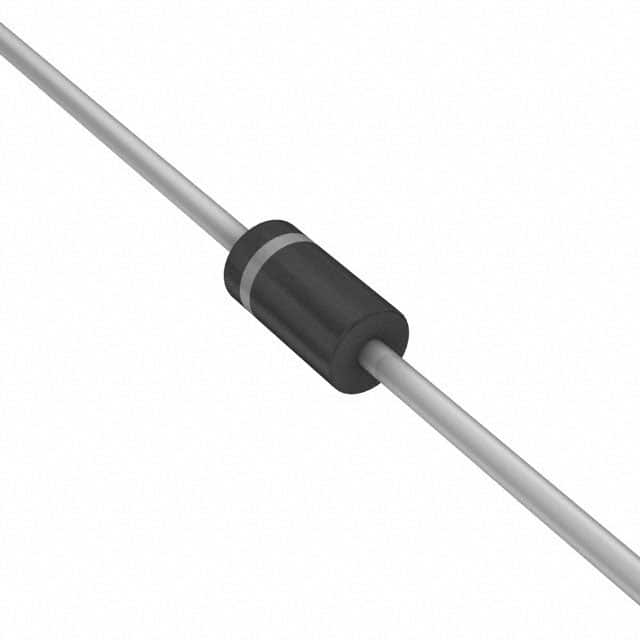Consulte las especificaciones para obtener detalles del producto.

1N486B Diode
Product Overview
Category
The 1N486B diode belongs to the category of semiconductor devices.
Use
It is commonly used for rectification and voltage regulation in electronic circuits.
Characteristics
- Forward Voltage Drop: 0.7V
- Maximum Reverse Voltage: 200V
- Maximum Forward Current: 1A
- Package Type: DO-41
- Operating Temperature Range: -65°C to 175°C
- Packaging/Quantity: Bulk packaging, typically available in reels of 1000 units
Essence
The 1N486B diode is an essential component in electronic circuits for converting alternating current (AC) to direct current (DC) and for voltage regulation.
Specifications
- Forward Voltage Drop: 0.7V
- Maximum Reverse Voltage: 200V
- Maximum Forward Current: 1A
- Package Type: DO-41
- Operating Temperature Range: -65°C to 175°C
Detailed Pin Configuration
The 1N486B diode has two pins, with the cathode being marked by a band on the body of the diode.
Functional Features
- Efficient rectification of AC to DC
- Low forward voltage drop
- High reverse voltage capability
- Compact DO-41 package for easy integration into circuits
Advantages
- Low forward voltage drop reduces power loss
- High reverse voltage capability ensures robustness
- Compact package allows for space-efficient circuit design
Disadvantages
- Limited maximum forward current compared to higher-rated diodes
- Operating temperature range may not be suitable for extreme environments
Working Principles
The 1N486B diode operates based on the principle of unidirectional conduction, allowing current to flow in only one direction while blocking it in the reverse direction. This property makes it ideal for rectification and voltage regulation applications.
Detailed Application Field Plans
The 1N486B diode finds extensive use in: - Power supply circuits - Voltage regulators - Rectifiers in electronic equipment - Battery charging circuits
Detailed and Complete Alternative Models
Some alternative models to the 1N486B diode include: - 1N4001: Similar characteristics, lower maximum reverse voltage - 1N5408: Higher maximum reverse voltage, higher forward current capability - 1N4148: Lower power dissipation, faster switching speed
In conclusion, the 1N486B diode is a versatile semiconductor device that plays a crucial role in electronic circuits for rectification and voltage regulation. Its compact size, efficient operation, and robust characteristics make it a popular choice for various applications in electronics.
[Word Count: 386]
Enumere 10 preguntas y respuestas comunes relacionadas con la aplicación de 1N486B en soluciones técnicas
What is the 1N486B diode used for?
- The 1N486B diode is commonly used for general-purpose rectification and power applications.
What are the electrical characteristics of the 1N486B diode?
- The 1N486B diode typically has a maximum repetitive peak reverse voltage of 200 volts, a maximum average forward current of 1 ampere, and a forward voltage drop of around 1 volt at 1 ampere.
Can the 1N486B diode be used in high-frequency applications?
- The 1N486B diode is not recommended for high-frequency applications due to its relatively slow recovery time.
Is the 1N486B diode suitable for use in switching power supplies?
- Yes, the 1N486B diode can be used in low-power switching power supply applications.
What are the typical package types available for the 1N486B diode?
- The 1N486B diode is commonly available in axial-lead glass packages.
What are the temperature considerations for the 1N486B diode?
- The 1N486B diode is typically rated for operation within a temperature range of -65°C to +175°C.
Can the 1N486B diode handle surge currents?
- The 1N486B diode has a non-repetitive peak surge current rating of 30 amperes for a 60Hz half-sine wave.
What are some common applications for the 1N486B diode?
- Common applications include general-purpose rectification, freewheeling diodes in power supplies, and reverse polarity protection.
Does the 1N486B diode require a heat sink for certain applications?
- For high-current or high-power applications, a heat sink may be required to dissipate excess heat from the diode.
Are there any notable limitations or drawbacks of using the 1N486B diode?
- One limitation is its relatively slow recovery time, which makes it unsuitable for high-frequency applications. Additionally, it may not be ideal for very high-power applications due to its current and voltage limitations.

